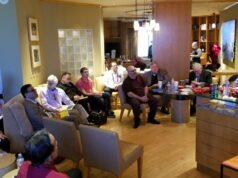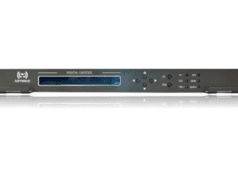Washington DC /November 12, 2014 – The Advanced Television Broadcasting Alliance (ATBA) last week delivered responses to questions to Communications and Technology Subcommittee Chairman Emeritus Joe Barton’s additional questions for the record relating to the July 24, 2014 Subcommittee hearing on the LPTV and Translator Act of 2014.
“The ATBA is pleased to continue the important dialogue regarding the need for a legislative solution to assist LPTV and translator stations struggling with the uncertainty caused by the FCC’s incentive auction,” according to Louis Libin, ATBA Executive Director. “We so appreciate Chairman Walden and Chairman Emeritus Barton’s continued support for these efforts.”
The Response to Additional Questions is listed below.
Responses to Additional Questions for the Record by The Honorable Joe Barton Louis Libin, Executive Director, Advanced Television Broadcast Alliance
- It is known that US manufacturers of equipment for LPTV and TV translator stations are suffering serious financial losses because of uncertainty about the fate of the LPTV and translator channels in the auction. Two of these manufacturers are Larcan and Axcera. Under financial pressure arising from marketplace doubts about the future for small TV stations, both have recently closed their US facilities with the loss of many jobs.
Without some legislative protection for small TV stations, is it true that the auctions are likely to cause loss of not only TV jobs but loss of many good manufacturing and engineering jobs in America?
The FCC’s ongoing Incentive Auction proceedings have created growing uncertainty in the broadcast industry that has slowed the purchasing of broadcast equipment to an all-time low. Not since 2009 has the market been so depressed and so little spent on broadcast and related products. The FCC’s actions have caused most TV stations to significantly reduce capital expenditures and to delay wherever possible the purchase of broadcast equipment, in particular transmission products and related ancillaries.
We have witnessed the devastating impact of the Inventive Auction over the last 12 months on broadcast manufacturers. U.S.-based manufacturers such as Acrodyne, Axcera, Dielectric, Modulation Sciences and Larcan have all been dramatically affected to the point where they have closed operations and no longer manufacture any broadcast equipment. Dielectric has since re-opened but with a much smaller workforce. The job loss is not just confined to the several hundred engineers who work directly for these companies; rather, the impact is felt by the large number of people who provide services to the closed factories. For each engineer, there is likely a “times ten” multiple of people impacted by these losses. These factory closures not only reduce the available domestic suppliers but weaken the possibility of further U.S. innovation in this market segment. U.S. transmission product manufacturers were once recognized as world leaders in broadcast technology and exported many hundreds of millions of dollars of transmission equipment around the world.
Due to the lack of demand, even foreign manufacturers in the U.S. such as Screen Service, Elettronika and DMT have ceased domestic operations. Without the requirement of TV transmitters, transmission lines, and RF components such as combiners and filters and antennas, we estimated that many thousands of U.S. workers would lose their jobs, and the value of American expertise and leadership in this field will be lost forever.
Over the last three years, sales for most existing TV transmission product manufacturers have dropped by at least 75 percent. The average sales over the last 20 years of RF products are approximately $600M/year, of which at least 20-30 percent came from exports. Today, it is estimated that sales of broadcast transmission products for the last two to three years has plummeted to less than $150M/year. Sales are expected to fall even further in 2015 and 2016. Further reduction in sales of broadcast transmission products will inevitably put more companies out of business, result in thousands of jobs lost, and, worse still, minimize the potential of any further exports of U.S.-manufactured RF products.
If there are fewer U.S. companies to provide broadcast transmission equipment, then this will significantly impact the possibility of what the FCC wants: a short-term re-packing of the spectrum. Even today, a significant re-pack cannot possibly be accomplished in the time currently forecasted; however, if many more companies go out of business, it will almost make any re-pack near impossible. If stations cannot purchase new equipment in a timely manner, if equipment cannot be re-tuned by experts, and if products cannot be installed in a timely manner, the re-pack will fail due to lack of resources, or in a worst case scenario, will put hundreds of TV stations out-of-business.
Without a clear understanding of how and when the re-pack will happen and to whom it will impact, most broadcast transmission equipment manufacturers will not be able to recover, with the consequent further loss of jobs, loss of exports, and loss of a world leading U.S. industry. Legislative protection is needed to prevent these dire consequences.
- The Federal Communications Commission is protecting full power stations in the auction, but they have not offered any protections to low power stations. Can you please explain the difference between full power stations and low power stations? Do you believe that viewers really know the difference? Who are these viewers?
Low Power Television (LPTV) stations operate at much lower power levels and typically serve much smaller coverage areas than full power stations. LPTV service was created to provide greater diversity in free over-the-air television and fill a void in communities that were not fully covered by full power broadcasting.
The Federal Communications Commission (FCC) originally established LPTV service to enhance diversity and to achieve full utilization of the TV broadcast spectrum. The nature of full power television broadcasting demanded that the FCC require a significant geographical separation of hundreds of miles to prevent the signals of television stations operating on the same channel from interfering with each other. These requirements left gaps in the spectrum that provided an opportunity for smaller or lower power TV stations to operate without interfering with full power stations. LPTV stations were also created for niche broadcasting to address the need of minorities, women, and special interest groups, and for broadcasting in rural areas where full power stations were not able to serve the communities effectively. The ownership of LPTV stations is also diverse; for example, females own approximately 15 percent of LPTV stations.
LPTV service was designed to “fill in the gaps,” so, unlike full power TV, interference protection could not be guaranteed to LPTV operators. LPTV stations are “secondary” to full power stations – LPTV stations cannot cause interference to full power stations and cannot protest interference they receive from full power stations. The FCC never intended for LPTV to be secondary to wireless services.
Most full power stations are owned by large corporations or other institutions, while a large portion of LPTV broadcasters are “mom and pops” – hometown businesses that are serving their communities, providing hyper-local programming including civic affairs, local church services, weather alerts and unique programming for cultural minorities, linguistically isolated audiences, and people of faith. For example, CFNT-TV in Wichita Falls, Texas covers a target community of 100,000 and offers countless hours of public service announcements and local information programs featuring local non-profits and more. Likewise, in California’s Bay Area, more than 300,000 Filipino residents have access to local news and feature programs in both the Tagalog and English languages on the LPTV FilAm Network.
From the perspective of the viewer, other than the unique hyper-local and community-specific programming that is offered, there is no difference at all between low power and full power stations. Translators that carry major network affiliates far into isolated rural areas are indistinguishable from full power stations from the viewer’s perspective. Viewers receive LPTV and translator stations using the same receivers and antennas they use to receive full power stations.
The LPTV industry is just now getting back on its feet from the “digital repack and transition.” These “mom and pop” stations had to spend, in some cases, on the order of hundreds of thousands of dollars for new transmitters, antennas and broadcast infrastructure to conform to the digital standard. Many others had to move out of the way for a full power station and had to spend even more money filing for a new frequency.
More than 5,000 LPTV and TV translator stations across the country are serving consumers today. But the uncertainty created by the FCC’s actions is preventing new investment in digital upgrades and new stations. Viewers do not know that the LPTV stations and translator stations they watch may simply vanish and never be seen again if they are eliminated by the FCC.










